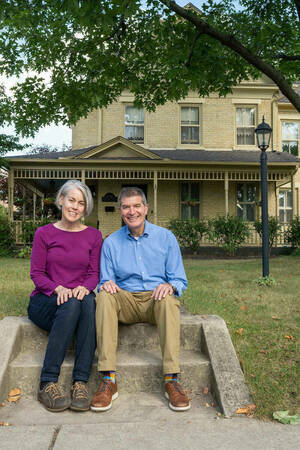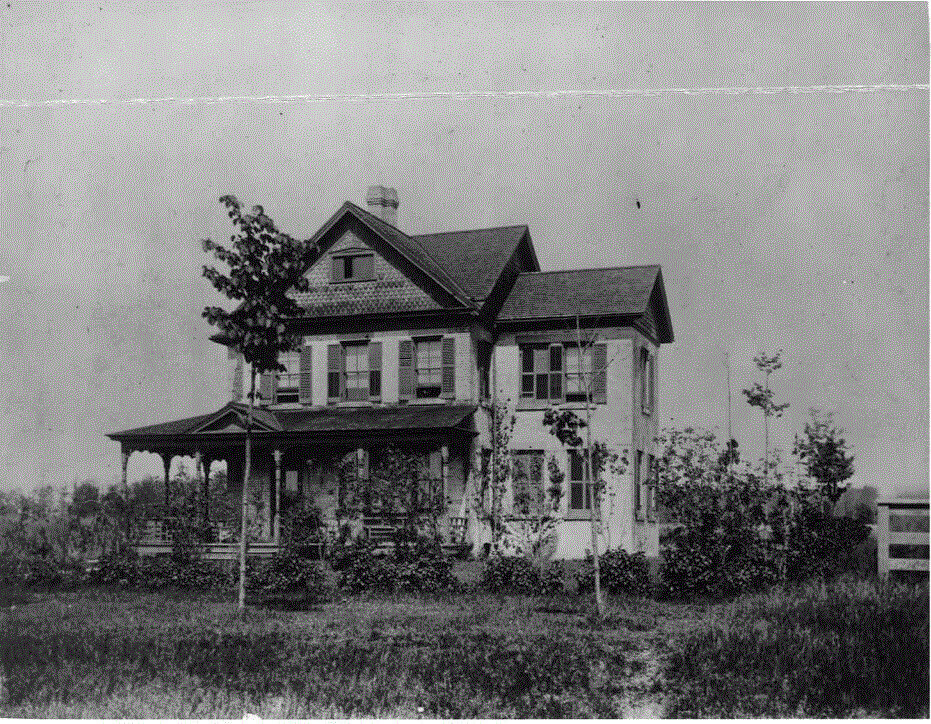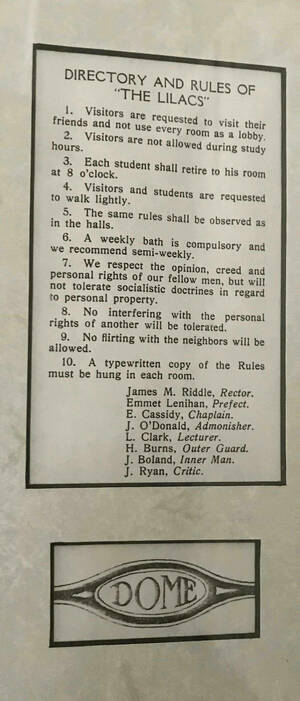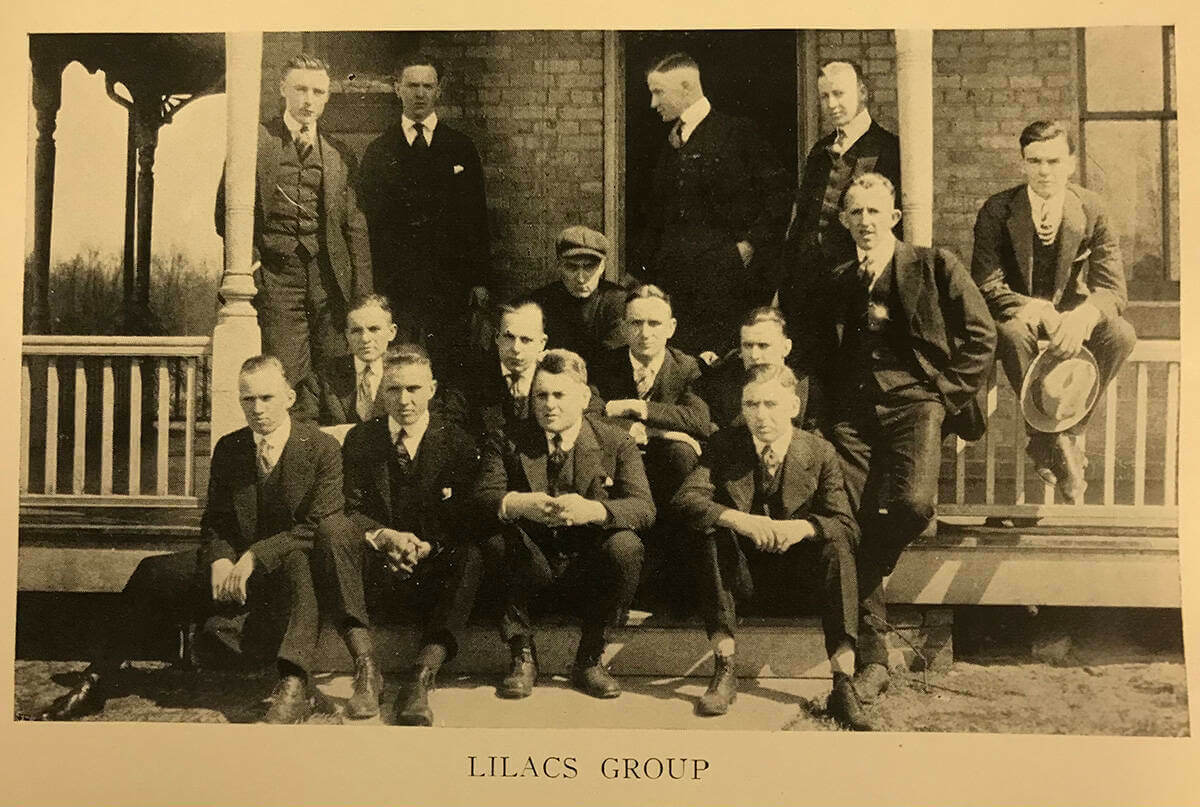The yellow brick house looks much as it did when it was new in 1889, although its surroundings have changed dramatically.
It stands on the southeast corner of Notre Dame Avenue and Napoleon Boulevard, just a block from the entrance to campus. The house — serving variously over the years as a residence for faculty, students and alumni — has been intertwined with Notre Dame throughout its history.

Today it’s the home of Joseph Harmon ’85 and Julie (Thurin) Harmon ’85. The couple has owned it since 1995 and raised their four children there.
Named “The Lilacs” by its first resident — Notre Dame professor Maurice Francis Egan, a prominent Catholic author, journalist, poet and editor — 1136 North Notre Dame Avenue still lives up to that sobriquet. It’s surrounded by lilac bushes that each spring fill the yard with rich color and fragrance.
Egan’s autobiography, Recollections of a Happy Life, includes a photo and fond remembrances of the house. “We determined to call it The Lilacs, as this part of Indiana was beloved of the lilacs,” he wrote. “They grew profusely wherever they were planted.”
It has a high gable roof, large double-hung windows and a wide front porch that hugs the west and north sides. Inside there are hardwood floors, two fireplaces and decorative woodwork.
The exterior yellow bricks look familiar to those acquainted with Notre Dame’s past. The house matches many of the early campus buildings that were constructed of bricks made of clay from the campus lakes.
The Queen Anne-style, three-bedroom home was built for Egan when he joined the Notre Dame faculty. He moved here from New York with his wife, Katherine, and their three young children.
Rev. Thomas E. Walsh, CSC, Notre Dame’s president, ordered the house constructed. The priest promised Egan a family home near campus and named him the University’s “Chair of Literature.” (The faculty position was not endowed. It would be many years before an endowed professorship would exist at Notre Dame.)
The Lilacs was designed by Charles A. Brehmer, a pioneering local architect who studied at Notre Dame.
Born in 1852 in Philadelphia, the son of an Irish immigrant father, Egan was a well-known Catholic writer and journalist by the 1880s. He had a previous charitable connection to the University. In 1879, he published Preludes, a collection of his poetry, with proceeds donated to Notre Dame to help rebuild from the Great Fire that destroyed the Main Building and several other campus structures.
Construction started in 1888 and the house was completed by spring 1889, the same year Sorin Hall opened as the University’s first free-standing residence hall for college students. The bricks for the house reportedly were left over from the construction of Sorin.
Professor Egan asked friends to send him lilacs to plant in the garden of his new home. Irish poet Aubrey de Vere sent a white lilac, American critic and poet Edmund Clarence Stedman sent a “beautiful Persian” variety, English poet Coventry Patmore contributed a deep purple one, and so on.
Egan was known for hosting elegant dinners and teas at his home, with visiting writers and dignitaries in attendance. “To ‘The Lilacs,’ a little cottage on N. Notre Dame Ave., (Egan) came, and there on many a week-end afternoon gathered the intellectuals of the middle west,” Scholastic magazine recalled years later.
The Egan family lived there until 1895, when the professor joined the faculty at The Catholic University in Washington, D.C. In 1907, he was appointed by President Theodore Roosevelt as U.S. minister to Denmark, a post he would hold until 1918. In 1916, Egan negotiated the U.S. purchase of the Danish West Indies — today’s U.S. Virgin Islands. He died in 1924.

When it was built, The Lilacs was in a little developed area on the north edge of South Bend. The Harmons have an early photo in which the home looks like a farmhouse — surrounded by fields, with two slender saplings out front.
After the Egans left, The Lilacs served as a home for years for various faculty members, including music and German professor Charles Petersen and his wife, until Petersen’s death in 1913.
A shortage of dormitory space around World War I pushed some students off campus. As a result, students — as many as 17 at a time — lived in The Lilacs in 1915, 1916 and 1917. The young men created their own off-campus community, forming a hall football team and hosting evenings of musical entertainment for fellow students.
A 1917 city map shows the house still standing largely alone on the outskirts of the city, with just a few other homes on nearby blocks. A city streetcar line ran along Notre Dame Avenue. To the north, farm fields stretched to the edge of campus.
City directories indicate Petersen’s widow — Julia Petersen — was the owner and primary occupant of the house from about 1920 until her death in 1949. She rented out rooms to Notre Dame students, who affectionately called her “Ma Pete.” In the years just after World War II, facing another on-campus housing shortage, as many as four or five students a year boarded at The Lilacs.
In 1950, Notre Dame chemical engineering professor Murlin Howerton was living in The Lilacs. By 1957, Leo “Zeke” Zuckowsky ’48, ’50M.S. ’61PhD — a former mayor of Vetville, Notre Dame’s post-World War II married student housing complex — was the owner and resident.
Notre Dame political science professor Edward A. Goerner ’52 and his wife, Marilyn, bought The Lilacs in 1962. They lived there for three decades and raised their family there. The Goerners added a wood frame one-story east wing and a garage.
All five Goerner children are Notre Dame graduates — Peter ’78, Liza Crisafi ’81, Meg Collins ’81, Kate Munhall ’82 and Becky Goerner Bach ’88. They have fond memories of their childhood home.
“The Notre Dame campus served as our playground in the summer: biking around the lakes, swimming at St. Joseph’s Lake, ice cream cones at The Huddle back when it had a full ice cream counter,” Bach recalls. The siblings set up a lemonade stand on their front lawn on football Saturdays, walked to Sacred Heart for Mass and from their front porch listened to the Notre Dame Marching Band rehearsing a few blocks away.

At one point, the city decided to widen Napoleon Boulevard and a crew showed up with a bulldozer to remove the lilac bushes along the north side of the house. Her mother rushed outside and stood in front of the bulldozer to save the bushes, Bach says. A compromise was reached: The crew uprooted the lilacs but replanted them closer to the house so the curb could be installed.
Maurice Francis Egan’s grandson – Gerald Ambrose O’Reilly – attended Notre Dame, graduating in 1947 after taking a leave of absence to serve in the U.S. Army during World War II.
Gerald O’Reilly’s memoir, Nuns, Nazis, and Notre Dame, was published a year before his 2018 death. In the book, he recounted that his grandfather “had the distinction of being Notre Dame’s first lay professor with a wife and children, prompting the university to build him a yellow-bricked home (near) campus, which my mother loved dearly.” (O’Reilly’s mother, Carmel Katherine Egan O’Reilly, was the Egans’ youngest child.)
“That house was so special to my dad and his mother,” says Peter O’Reilly ’94, son of Gerald and great-grandson of Maurice Francis Egan. He recalls visiting South Bend and attending Notre Dame football games with his father while growing up. “Pretty much every year, we’d walk to The Lilacs, stop there and connect with the owners,” he recalls.
Notre Dame in 1910 had presented Egan with its Laetare Medal, which is awarded annually to a Catholic “whose genius has ennobled the arts and sciences, illustrated the ideal of the Church and enriched the heritage of humanity.”
Gerald O’Reilly inherited his grandfather’s Laetare Medal and often carried it as a talisman for luck during Notre Dame football games. In 2003, he wrote an essay for this magazine about how he lost the medal at an airport and the University replaced it.
The replacement Laetare Medal remains in the family and is now in the safe keeping of Peter O’Reilly, who continues the family tradition of touching it for luck during ND games.
After the Goerners, another family owned the house for three years before the Harmons bought it.
As the Harmons prepared to move to South Bend when Joe, an obstetrician, was beginning his medical practice, they knew they wanted to live in an old house. It seemed fate drew them to the home, as there was a “for sale” sign outside The Lilacs. The Goerners had made upgrades to the house, which the Harmons say was in “very good condition” when they bought it.
They were attracted to life in an urban neighborhood. “And I liked the idea of being able to walk to Notre Dame,” Julie Harmon says.
The Harmons have deep Notre Dame roots on both sides of the family. Joe’s grandfather, Joseph P. Harmon Sr. ’25, played football alongside the Four Horsemen under Knute Rockne. His late father, Joseph P. Harmon Jr., attended Notre Dame before leaving for service in the Korean War. Julie’s late father was John P. Thurin ’59, an editor-in-chief of The Dome and, in the late 1960s, director of University publications and editor of Notre Dame Alumnus magazine.

The Lilacs was added to the National Register of Historic Places in 1999. The property has changed a bit since the Egans’ day — there’s a basketball half-court in the side yard and the Harmons recently added rooftop solar panels — but no major alterations.
The Harmons raised their three sons and daughter there. With three small bedrooms, sometimes it seemed a bit tight. “It just took a little patience,” Joe says.
The couple has watched major changes in the surrounding neighborhood. After decades of economic challenges and physical decline, the neighborhood in recent years has seen a growth boom: new single-family houses and townhomes, as well as development of the nearby Eddy Street Commons retail-office-apartment complex. Some nearby houses have been pulled down and replaced with new residential construction.
Through it all, The Lilacs stands — looking much as it did 133 years ago.
Although regularly contacted by individuals interested in buying their property, the Harmons have no plans to move from their home of 27 years.
Joe is now an assistant professor at Indiana University School of Medicine-South Bend, which is just to the north of their house. He walks one block to work.
“We enjoy it here,” he says.
Margaret Fosmoe is an associate editor of this magazine. Contact her at mfosmoe@nd.edu or @mfosmoe.